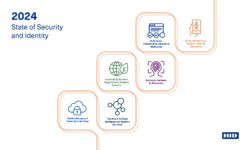Tough Challenges Ahead for Physical Security Market Despite Growth in 2017
A report by Memoori lays out difficult market conditions for many physical security vendors that are challenged to compete in an era of margin pressure.

According to Memoori, the total value of physical security products at factory gate prices in 2017 was $29.2 billion, an increase of approximately 5% compared to the prior year. This is a decline in growth from its peak in 2014 but an increase on the last two years.
A newly released physical security market report by Memoori sheds light on major technical and commercial challenges that are expected to fuel bruising supply-side pressure and significantly reshape the business over the next five years.
Memoori’s “Physical Security Business, 2017 to 2022” indicates the total value of physical security products at factory gate prices in 2017 was $29.2 billion, an increase of approximately 5% over the previous year. That marks a weakening in growth from its peak in 2014, but an increase on the last two years.
Over the past 8 years the market has experienced a compound annual growth rate of 6.4%, and Memoori forecasts the market will reach $41.3 billion in 2022 at a CAGR of 7.2%.
Memoori Managing Director James McHale states that key drivers for growth are firmly entrenched to match the profitable growth experienced throughout the industry from 2010 to 2014. However, a chief strategic stumbling block that currently preoccupies a majority of vendors is how to operate profitably and survive the severe squeeze on margins referred to as the “race to the bottom.”
The gap between the major suppliers and the many hundreds of smaller suppliers is widening with each passing year, according to the report. Concurrently, profit margins are falling which in turn increases the minimum economic size to operate profitably in the industry.
The video surveillance sector is especially being affected by declining margins; however, McHale tells SSI within the next five years the trend can be expected to take hold in the access control and intrusion alarm sectors.
“[T]here is some evidence that price pressures are starting to bite in access control and this will eventually have a negative effect on growth when measured by value. There also appears to be reluctance by manufacturers to support open standards in order to protect their heritage business,” he says. “This could damage their long-term future and open the way for Chinese manufactures to take up the initiative and make a strong push into the business they have started to target.”
In the video surveillance business, Dahua and Hikvision in particular have adopted a disruptive strategy by undercutting the profit margin of incumbents, while at the same time expanding markets and rapidly growing market share, according to the report. The gap in size between the two Chinese manufacturers compared to the next tier of western companies is so wide that it looks highly improbable it can be reversed by competing solely on price, according to the report.
The continued commoditization of video surveillance products requires a strategy that broadly focuses on pursuing volume through the small- to medium-sized business (SMB) market or brand through the enterprise business. McHale projects that no more than five companies by 2022 will thrive by operating in both markets concurrently.
Major companies such as Axis Communications, Avigilon, Bosch, Panasonic and Hanwha are in a position to reduce their margins sufficient to retain market share, he posits. Yet to continue growing market share, these and other vendors will be forced to increase investment in innovative products that provide end users an improved total cost of ownership (TCO) metric, but with depleted margins they would need to increase their financial resources.
Adopting a strategy of developing strong brands with end-to-end solutions for key vertical markets, along with forging strong alliances with other building automation system (BAS) providers, has improved growth and financial performance in 2017 for a number of these companies, McHale says.
“Specialization in a number of vertical markets is a practical strategy to more than survive, particularly now that the Internet of Things [IoT] is gaining traction,” he says. “But this may seduce companies to sell direct to the end user and ultimately become system integrators where the demand for services is rapidly expanding.”
Memoori’s reports shows there is evidence to suggest that in the United States some systems integrators are finding access control more profitable than video surveillance.
“This has motivated them to spend more time and effort in promoting this business. The competitive landscape is much more stable than video surveillance and the market is not yet subject to the proliferation of Chinese products seen in video surveillance,” McHale explains.
McHale provided the following forecast overviews for the three major equipment sectors:
Access control — Of the three, still largely independent businesses, access control has maintained its average growth of approximately 7% over the last three years, and takes a share of 23.5%.
The drivers that have delivered this growth are increased penetration of IP Network systems, further advances into biometric readers, identity management and wireless locking systems. This is the second consecutive year that it has turned in the highest rate of growth of the three businesses. However there is some evidence that price pressures are starting to bite and this will eventually have a negative effect on growth when measured by value.
Intrusion alarms — The intrusion system business takes a 22% share. It is the “father” of the physical security industry and has long since reached maturity, but its increasing use of radar and thermal cameras has contributed to growth edging up to 2.5% in 2017. The use of radar, advances in sensor technologies, wireless technology and the integration with video surveillance, access control and outdoor lighting have all contributed to growth in the sector.
Video surveillance — In 2017 the market for video surveillance products totaled $15.9 billion, marking a growth of 5.9% on 2016 and takes a 54.5% share of the physical security business. This level of growth looks disappointing compared with growth over the previous five years, which averaged around 9.7%. However, this has been a relief to many suppliers that believed 2017 would struggle to improve on 2016 if the drastic fall in camera prices over the previous two years continued.
It has, and this has put a great deal of stress on profitability particularly for manufacturers in the western world. Memoori expects the demand for branded products in the enterprise market will run at higher levels due to integration across all three security services, and other BAS services and convergence with IT. This should ensure the market will be worth $22.8 billion in 2022.
Systems Integration and the Cybersecurity Play
Shared intelligence and systems integration is seen as driving business opportunities in new vertical markets, according to McHale. One example: a growing need for electrical utilities to monitor remote renewable power generation and electrical transmission and distribution networks.
“This vertical could become a significant one eventually taking as much as 5% of the market, and today it would not amount to more than .5%,” McHale tells SSI. “Transmission and distributed transformer sites are not manned and have become targets for cyber as well as physical threats. The number of transformer sites in the U.S. alone runs to tens of thousands.”
Among other disruptive factors altering the market landscape — which can be viewed as either a threat or an opportunity — include: cybersecurity; deep learning and artificial intelligence (AI); SaaS and Big Data; integration and IT convergence; and IoT technology.
McHale says he is surprised by the industry’s lackluster response to cybersecurity issues, which could become a significant barrier to growth if not handled properly. For those companies that fully grasp the challenge, it could become a key competitive advantage.
Memoori advocates a layered approach to cybersecurity. Where possible, systems should be isolated to limit the potential of a would-be attacker to “pivot” or “bridge” between different systems on a network, through the adoption of stringent access control, authentication and permissions protocols on systems within a network.
“There is a growing need for physical security and cybersecurity to be more connected,” he tells SSI. “Departments that manage the technology for these two types of security are often entirely separate. Greater convergence is long overdue at an organizational level in companies.”
If you enjoyed this article and want to receive more valuable industry content like this, click here to sign up for our FREE digital newsletters!

Security Is Our Business, Too
For professionals who recommend, buy and install all types of electronic security equipment, a free subscription to Commercial Integrator + Security Sales & Integration is like having a consultant on call. You’ll find an ideal balance of technology and business coverage, with installation tips and techniques for products and updates on how to add to your bottom line.
A FREE subscription to the top resource for security and integration industry will prove to be invaluable.














